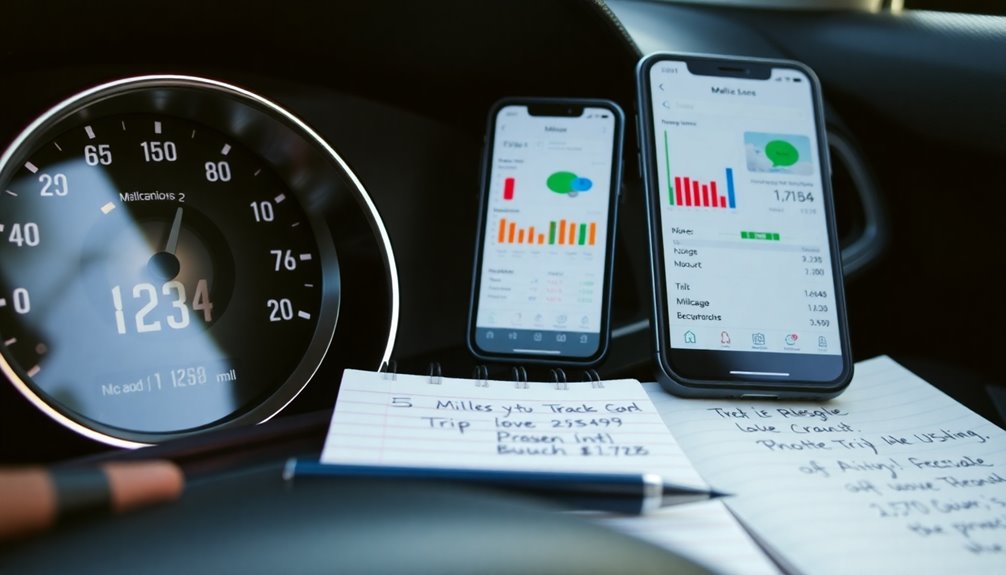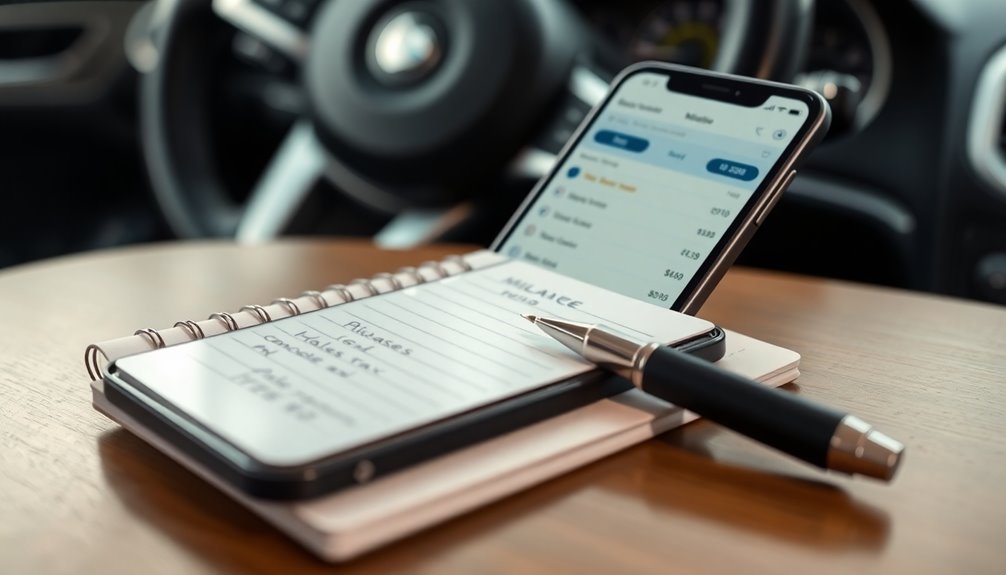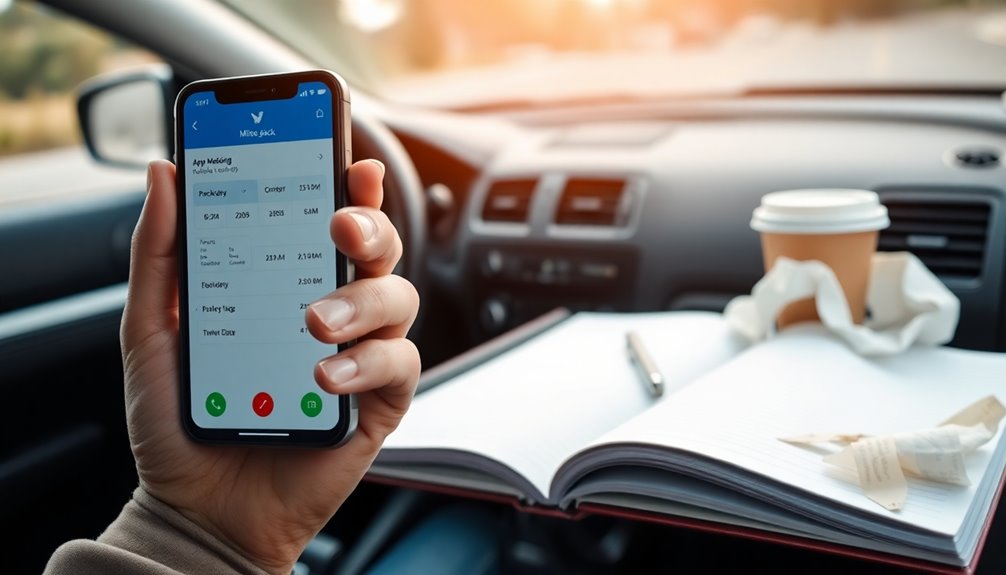To record mileage for taxes, start by keeping a detailed log of your trips, noting the date, purpose, locations, and odometer readings. You can use manual logging or opt for mileage tracking apps that automatically capture this information. It's crucial to separate business and personal miles and keep your logs organized for at least three years. Accurate records not only comply with IRS requirements but can also maximize your deductions. Regular updates will help maintain detail and accuracy, ensuring you don't miss out on eligible expenses. If you stay with us, you'll discover more tips to optimize your mileage tracking.
Key Takeaways
- Maintain a detailed mileage log with date, purpose, locations, and odometer readings for each trip to ensure accuracy and compliance.
- Use mileage tracking apps for automatic logging, which simplifies the process and generates IRS-compliant reports.
- Record vehicle odometer readings at the start and end of the tax year to calculate total business miles accurately.
- Separate personal and business miles, and exclude daily commuting miles to maximize deductible expenses.
- Keep records for at least three years, including receipts for any additional travel expenses incurred during business trips.
Understanding the IRS Mileage Rate

When it comes to tax season, understanding the IRS mileage rate is crucial for maximizing your vehicle expense deductions. The IRS sets these rates to help you calculate deductible vehicle costs for business, charitable, and medical use of your personal vehicle. Each category has its own rate, reflecting the different costs associated with each purpose.
For instance, in 2024, the business mileage rate is 67 cents per mile, while medical use is 21 cents per mile. Charitable mileage holds steady at 14 cents per mile for both 2023 and 2024. Three standard mileage rates exist, making it essential to classify your travel accurately.
These rates can change annually and may even shift mid-year based on fluctuating costs, like gas prices. The IRS bases these adjustments on data from Motus, ensuring the rates reflect real-world expenses.
When you track your mileage, remember that the business mileage rate covers both fixed costs—like depreciation and insurance—and variable costs, such as fuel and maintenance. In contrast, the medical and charitable rates only consider variable costs.
Methods for Tracking Mileage
How can you effectively track your mileage for tax purposes? You have several methods at your disposal. One straightforward approach is manual mileage logging.
Grab a dedicated notebook or logbook, and record the date, start and end locations, the purpose of your trip, and odometer readings for each journey. This method requires diligence, as you'll need to regularly update your log to avoid missing important details.
Alternatively, consider using mileage tracking apps. These tools leverage GPS or Google Maps to automatically track miles driven for business. They can generate IRS-compliant reports and allow you to classify trips with a simple swipe. Tracking mileage can lead to significant tax savings for self-employed individuals, making it a worthwhile investment.
If you prefer a more mechanical approach, set your odometer readings at the start and end of the tax year to establish a baseline. Use the trip setting on your odometer for each business trip, resetting it to zero before starting.
Lastly, leveraging technology for automation can save you time and reduce errors. Automated apps can track and log miles, categorize them, and securely store records in the cloud for easy access and IRS compliance.
Essential Details for Logs

Accurate logs are vital for maximizing your tax deductions and ensuring compliance. To create effective logs, note the date and purpose of each trip, along with the total miles driven. Start by recording your odometer readings at the beginning and end of the tax year, as well as before and after each business trip. This way, you can accurately calculate your total business miles.
When documenting each trip, specify the business destination and the purpose behind it. Don't forget to include any additional travel expenses, like parking or tolls, but remember to exclude your daily commute to your regular worksite. It's essential to record miles driven for each specific business trip to maintain clarity. A mileage log is required for various categories including medical, charitable, and moving travel, which can further support your deductions.
For compliance, keep these records for at least three years in case of an audit. Regularly update your logs—weekly is a good practice—to ensure they remain timely and accurate. Use IRS-compliant formats for your record-keeping and include supporting evidence, like communications or receipts, whenever possible.
Avoid missing data, calculation errors, and incorrect mileage rates to strengthen your case if you face an audit.
Record Keeping Best Practices

Maintaining detailed and precise records is key to successful mileage tracking for tax purposes. Start by logging the date of each trip to create a clear timeline of your travels. Update your log regularly—daily or weekly—to keep your records accurate and complete.
For each trip, include your starting and ending odometer readings along with the total miles driven and the business purpose of the journey, such as meetings or client visits. Accurate documentation is essential for claiming mileage tax deductions, as it supports your tax deduction claims during audits.
Consider utilizing mileage tracking apps, which can automate logging and calculations, minimizing the risk of errors. Always back up your data, whether digitally or physically, to protect against loss. Make sure your digital tools meet IRS compliance standards for mileage logging.
Avoid common mistakes by clearly separating business from personal trips and using actual odometer readings instead of estimates. Keep thorough records, retaining all documentation like driving logs, receipts, and odometer readings for a minimum of three years.
Being organized and consistent in your record-keeping won't only help you during tax season but also prepare you for any potential audits.
Choosing the Right Method

When it comes to recording mileage for tax purposes, choosing the right method can significantly impact your deductions. You have two main options: the Standard Mileage Rate Method or the Actual Expenses Method.
If you drive a lot for business and have low vehicle expenses, the Standard Mileage Rate Method might be best for you. You simply multiply your business miles by the IRS standard rate, which is 67 cents per mile for 2024. This method requires less detailed record-keeping, but you still need a mileage log that includes dates, trip purposes, and odometer readings. Additionally, accurate tracking of business mileage is crucial to ensure you maximize your deductions.
On the other hand, if you have low mileage but high vehicle expenses, consider the Actual Expenses Method. This involves calculating your total vehicle expenses and multiplying by the percentage of business use. However, it requires meticulous record-keeping of all expenses, including fuel and maintenance.
Remember, once you choose a method for a vehicle, you generally need to stick with it in subsequent years.
Think about your driving habits, vehicle costs, and record-keeping preferences to determine which method works best for you.
Reporting Mileage on Tax Returns

After choosing the right method for tracking your mileage, it's time to report it on your tax returns. First, ensure you've recorded your vehicle's odometer readings at the beginning and end of the tax year.
Create a mileage log that captures each business trip's date, purpose, starting and ending locations, and odometer readings. Remember to reset your trip odometer before each trip for accurate tracking. Additionally, be aware of the standard mileage rates set by the IRS, which can significantly impact your deductible amount.
Calculate your total business miles by subtracting your starting odometer reading from the ending one, and make sure to separate personal from business miles. This distinction is crucial for accurate tax deductions.
For employees, report your business mileage on Form 2106, listing total miles on Line 12. If you're self-employed or a business owner, use Schedule C, Part II, Line 9, and complete Part IV with your vehicle information.
Fill in all forms accurately, and if available, leverage online tax filing systems that can convert your mileage logs into deductible amounts automatically.
Keep your documentation organized and compliant with IRS standards, retaining records for at least three years in case of an audit. This diligence will ensure a smoother reporting process.
Benefits of Accurate Tracking

Accurate tracking of your mileage can save you significant amounts on your taxes and streamline your financial management. When you maintain detailed mileage logs, you create a solid foundation for tax deductions. The IRS requires comprehensive records to substantiate any claims made on your tax returns. Without precise logs, you risk audits and potential penalties, making accuracy essential.
Tracking your mileage regularly not only assists in tax compliance but also helps you manage vehicle expenses effectively. By monitoring your travel, you can identify trends and areas where you might cut costs. Accurate logs also clarify the distinction between personal and business travel, which is crucial for financial planning and budgeting. Moreover, tracking mileage promotes eco-friendly driving habits by reducing unnecessary trips.
If you're self-employed, having precise mileage records is vital for claiming business expenses. Digital tools like automated mileage tracking apps simplify the process, ensuring you accurately capture the date, start point, endpoint, purpose of each trip, and exact mileage.
This automation saves you time and minimizes the risk of calculation errors, while also making reimbursement processes smoother. By adopting accurate tracking practices, you enhance your overall financial management while maximizing your tax benefits.
Common Mistakes to Avoid

Maintaining accurate mileage logs is just the first step in maximizing your tax deductions. To avoid common mistakes, ensure you detail every trip, including the business purpose. Skipping this can lead to lost deductions. Always log actual mileage instead of estimates; this helps maintain credibility with the IRS.
Don't mix personal and business trips. Confusing the two can inflate your business mileage and lead to incorrect deductions. Be sure to exclude commuting miles and any personal trips from your logs.
Stay informed about IRS rules and rates. Ignoring these can cost you. Know the difference between the standard mileage rate and actual expenses; switching between them incorrectly can complicate your records. Maintaining contemporaneous records is vital to substantiate your business mileage claims.
Finally, keep your documentation organized. Poorly maintained logs that lack essential details—like date, start and endpoints, and purpose—can raise red flags.
Ensure you keep receipts for deductible expenses like tolls and parking. Utilize IRS-compliant mileage tracking tools and ensure your records are easily accessible and audit-ready.
Frequently Asked Questions
Can I Deduct Mileage for Commuting to Work?
You can't deduct mileage for commuting to work. The IRS considers trips from home to your regular workplace as personal expenses, regardless of the distance.
However, if you travel to a temporary work location or between multiple jobs, that mileage may be deductible.
To maximize your deductions, keep a detailed log of your business-related trips and separate them from commuting miles.
Always check current IRS guidelines for any updates.
What if I Forget to Log a Trip?
If you forget to log a trip, don't panic.
Start by gathering any available records like calendar entries or receipts to reconstruct the details. You can estimate the mileage based on your usual routes or check GPS data if you have it.
Make sure to document the date, purpose, and locations of the trip. This way, you'll have a reliable record to refer back to later.
Just keep everything organized!
Are There Any Exceptions to the Mileage Rate?
Yes, there are exceptions to the mileage rate.
You can't use it if you've claimed depreciation or a Section 179 deduction on your vehicle.
For leased cars, you're locked into the mileage rate for the entire lease.
Additionally, if you're operating a fleet with more than five cars, you can't use the mileage rate either.
Keep these exceptions in mind to ensure you're following the rules correctly.
How Do I Handle Mixed-Use Vehicle Mileage?
To handle mixed-use vehicle mileage, you'll want to keep detailed records of your trips.
Start by noting your odometer readings at the year's beginning and end. For each business trip, log the date, purpose, and miles driven.
Use a mileage tracking app or manual log to ensure accuracy. Regularly update your records to capture all business-related trips, even short ones, like picking up office supplies or getting gas.
Can I Use My Personal Vehicle for Business Purposes?
Yes, you can use your personal vehicle for business purposes.
Just make sure to keep track of your business-related trips, like visiting clients or picking up supplies.
Remember, commuting and personal errands don't count.
You'll need to differentiate between business and personal use, as only the business portion is deductible.
Keeping a detailed log of your mileage will help you stay organized and prepared for any potential tax implications.
Conclusion
In conclusion, accurately recording your mileage for taxes is crucial for maximizing deductions and staying compliant with IRS guidelines. By understanding the mileage rate, choosing the right tracking method, and keeping detailed logs, you'll set yourself up for success. Don't underestimate the benefits of good record-keeping and avoid common mistakes that could cost you. With a little effort, you can make the process seamless and ensure you get the most out of your tax return.








